Beginner’s Guide to #VanLife: How to convert a van and learn to live in it
“One person in a van is a tramp, but two is an adventure.”
I’ll always remember the day Sam said that. It was an unlikely friendship — he was a recovering drug addict who liked his space, I was a clean-living outdoor girl hitching in his van — but somehow it worked. We were both sat on a wall, sketching. I was drawing the beach. Sam was facing the other way, resolutely sketching some bins.
We’d met in Raglan, New Zealand, one of those surf towns where life seems too perfect to be real. Everyone was happy and nice. The baristas were dedicated. The surf was always on. The food was organic. Soulful bands jammed the nights away in small bars. I walked the sun-soaked streets barefoot and blissful, till Sam arrived.
A postie from Nottingham, he’d never left the city until, one day, he’d got addicted to selling stuff. He’d even Ebayed his doors and carpets. When he owned nothing except a guitar, on which he could only play ‘Where is my mind’ by the Pixies, he’d set off abroad for the first time and swiftly got hooked on budget travelling.
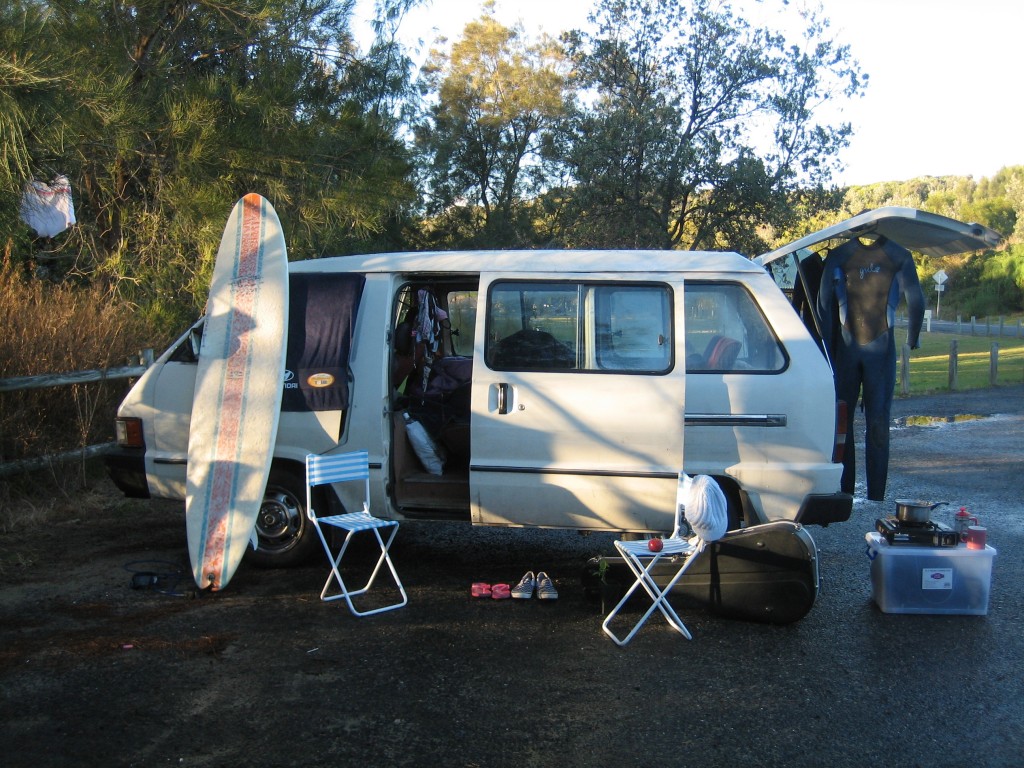
Home away from home
At first we hadn’t hit it off. He later confessed I’d seemed “a bit stuck up”. I’d thought he was a people-pleaser. When I coaxed that story out of him, though, I was impressed and amused in equal measure, and he said: “I just had my first real conversation in Raglan.” I sat quietly, realising I was young and full of myself sometimes.
Sam was gangly like a spider on a surfboard, and he behaved like a drug — pulling you high as a kite, laughing, or down with his grumps. Samba music always flows gently through Raglan. Once he drowned it out with Iron Maiden on the car stereo, then stalled the engine. “Put your shades on,” he instructed. “We can pull this off.”
For Sam, Raglan was too perfect. “I feel like I’m in a theme park,” he’d declared, and left for Australia, to buy his first van. His words broke the spell for me, too. It rained torrentially for a month. Then I booked a ticket for Australia as well. When I landed I received this text:
“Hi Sarah, sorry driving to Wollongong as Sydney is doing my head in as its to busy. Have fun on your travels!”
I wheedled Sam round, and he arrived, arms dangling, smiling, apologetic. Then I ruined it. I wanted a surfboard. “Let’s have a policy of honesty,” he said. “I hate shopping, and I don’t want to stay here tonight. If you pay for a night in a hostel for me, I’ll wait for you.” I smiled. I like honesty. Now we were really getting somewhere.
In the end I found a board quickly, and we headed up the coast, then turned off for Palm Beach because it sounded nice. Sam creaked open the back doors of his van and got a simple gas-powered hob out. It was always different, but that night the sun was tucked in pink candyfloss, and the dark sea was shimmering with pale blue sparkles.
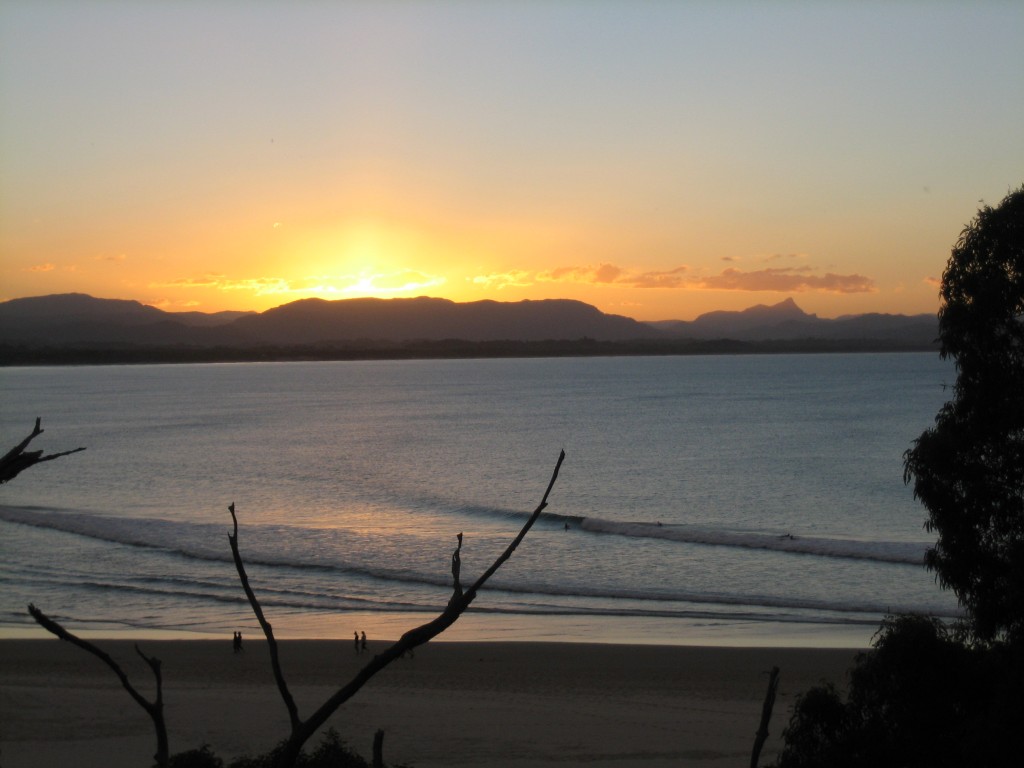
Perfect surf and a beautiful Australian sunset. Does life get any better?
We brewed tea in a saucepan, added cartons of UHT milk nicked from a cafe, and it was somehow a lot more exciting that way than made in a kettle indoors. “I have a tin of steak and vegetables and a tin of beans I can share with you,” said Sam. “And some mushrooms. I call this dish ‘stuff in a can with veg.’”
“Cool,” I said, smiling at Australia, Sam and the world in general. The van didn’t have a fridge, but things taste better outdoors, so it didn’t matter that we weren’t eating a la carte. Then he went for a moonlit walk over the rocks while I ran, swam, and started sketching. When Sam came back he joined me, and had something to say.
“It was fun on my own,” he said. “I’d play some guitar, drink a bottle of wine, pass out; you know, it was quite entertaining. But I’m glad you’re here. Sometimes I just get wound up and want to leave on my own. Anyway,” he added, grinning. “I’ve been thinking and realised that one person in a van is a tramp, but two is an adventure.”
Already slipping into a natural rhythm, I’d grown tireder as the sun sank and the air chilled. Sam settled to play guitar and smoke on a blue-striped deckchair. I was just thinking that I wouldn’t be able to sleep in a mini-van with no curtains and Sam playing the same song over and over, then I woke, refreshed, with the sun.
Together, we discovered a love for simple living, as we surfed and drove from Sydney to the Great Barrier Reef. I’d thought van life meant you had to be dirty, but beaches often have showers and toilets on them. I had no mirror, and went au naturel. We only had one set of cutlery, so we’d take it in turns with the fork and knife or the spoon.
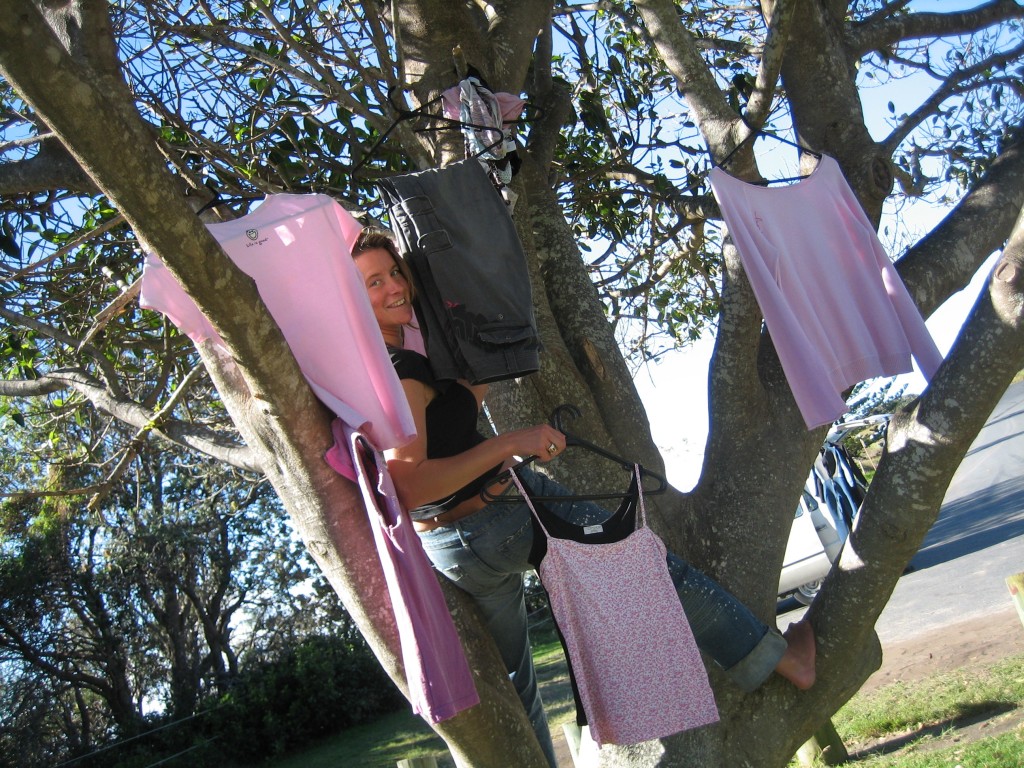
Keeping clean is key. Sarah gets inventive while hanging out the washing
I was desperate to learn to surf, but Sam preferred just bobbing on his board out back, because everyone was equal there. Then he’d read Watership Down and make sure I didn’t actually drown. He loved “Checkin’ up on them rabbits,” and when I got out, he’d always say, “You’ll never guess what that Clover’s been up to now!”
We hardly spent any money. Time passes differently in a van. Days whiled away gently. At night I’d sea-dream, and at daybreak it would lap me back in, pink-tinted, sometimes with dolphins. That was ten years ago, and I remember it all in the detail you preserve when you live slowly. Since then, I’d thought often about getting a van.
Then, last year, suddenly it felt like the right time. A friend asked me to spend a month in a van in the Pyrenees, running and climbing and wild swimming. While soaking up the arid cliffs and green mountains and rivers of Spain, I fell in love with the simplicity of van life all over again. At the end of the trip, I asked for her advice.
She wrote:
- VW Transporter: more expensive than other makes, but drive the most like cars. Also keep their value well.
- Tailgate rear door: useful for sheltering under when cooking, and hanging a shower from.
- 2.5 litre engine: to power you up steep mountain roads.
- Look for one with less than 100,000 miles on the clock and a good service history.
- Tinted windows allow light in while maintaining privacy.
That evening, my last in the Pyrenees, we drove past a van with a ‘For Sale’ sign on it. It was a VW Transporter with tinted windows and a tailgate. It was even red, my favourite colour. The price was 4,800 euros. All the similar ones we’d looked at on Autotrader that day had been between 6,000 and 10,000.
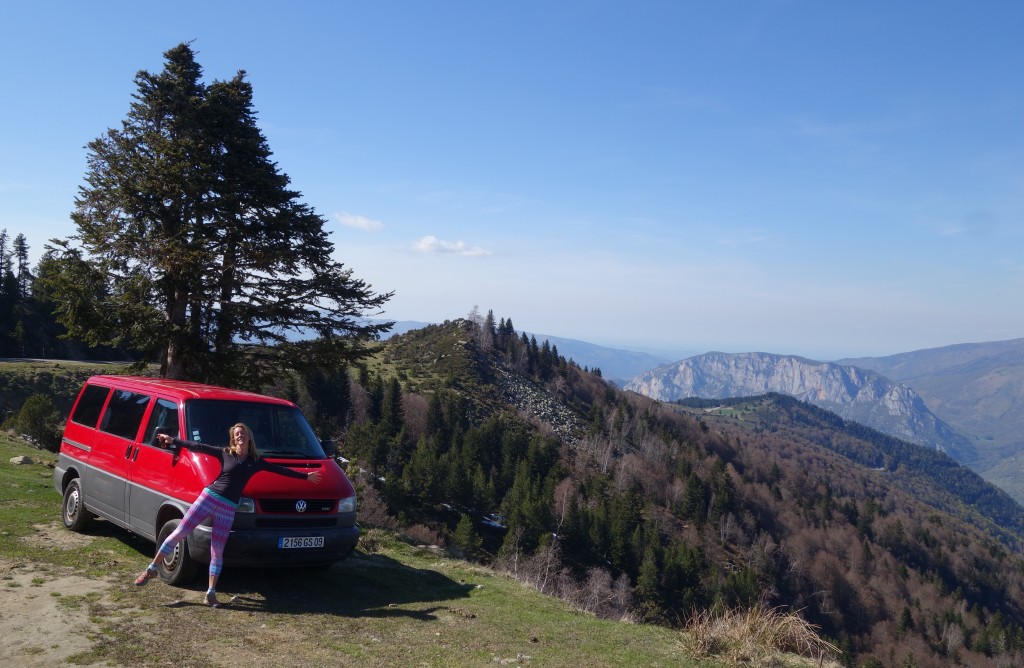
The dream van. Too good to pass up!
The door was opened by a friendly English lady, and a fat golden retriever with a teddy bear in his mouth. The van had a full service history, and had been well looked after for most of its life by her engineer husband. My friend needed to hit the road. “You can stay with us while we sort out the paperwork,” offered the English couple.
Things just got real. I was rapidly going to have to learn how to drive this thing all the way across France, and then figure out how to convert the thing…
How to convert your first van:
If you’re more of a glamper, this conversion isn’t for you. If, like me, you’d like to leave normal life behind and get back to basics on van holidays, then listen up! The whole job took us just two weekends.
We started by measuring the van, then went to a DIY store to buy the stuff needed for insulation, varnishing and painting; to a timber merchant to buy the wood for the wall panels, floor, ceiling and furniture; to a fabric shop for the curtain material; and ordered the things needed for the electronics online. Then we arranged to borrow a friend’s workshop.
Step 1: Insulation stage. For this you will need:
Several reels of builders’ roof flashing. Enough loft insulation to cover the ceiling and walls, and double the amount of thermal reflective insulation (a.k.a. tinfoil bubblewrap). And a heatproof spray glue gun (so everything doesn’t fall off!).
Step 2: Strip everything off and add roof flashing
Starting from behind the front seats, peel off all the plastic panels and strip off anything else like seat belts, then sweep thoroughly. Builders’ roof flashing is great for dampening noise! Liberally stick strips across the floor and wheel arches.
Step 3: Tinfoil bubble wrap and loft insulation
Stick the former to walls and ceiling wherever you’ll wood-panel (it repels moisture and reflects heat). Next glue on a layer of loft insulation (synthetic is recommended as it won’t go mouldy if gets to damp) then add another layer of tinfoil bubblewrap.
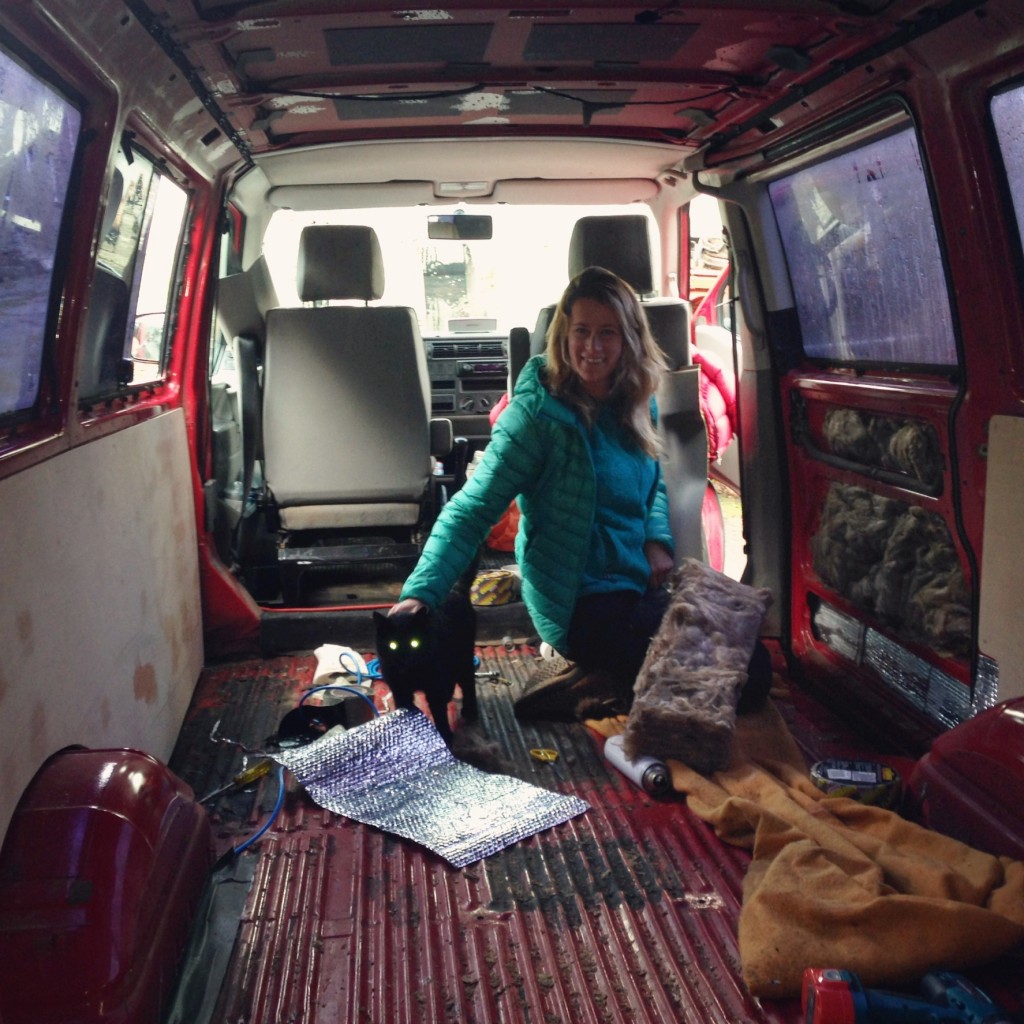
Step 4: Get the materials for the floor, walls and roof. You will need:
Enough 6mm plywood to cover the floor and walls (because we have windows, we panelled from below these to the floor, and left bare metal above). Tape measure, pen, paper, calculator, say, self-tapping screws, screwdriver, lino.
Step 5: Floor and walls
Stick two layers of tinfoil bubble wrap on the floor. Cut plywood panels to fit floor and walls, and attach with self-tapping screws. You can buy ready made ‘ply lining kits’ for most vans on the internet if you prefer. We then added lino and varnished the walls, but some prefer stretch carpet.
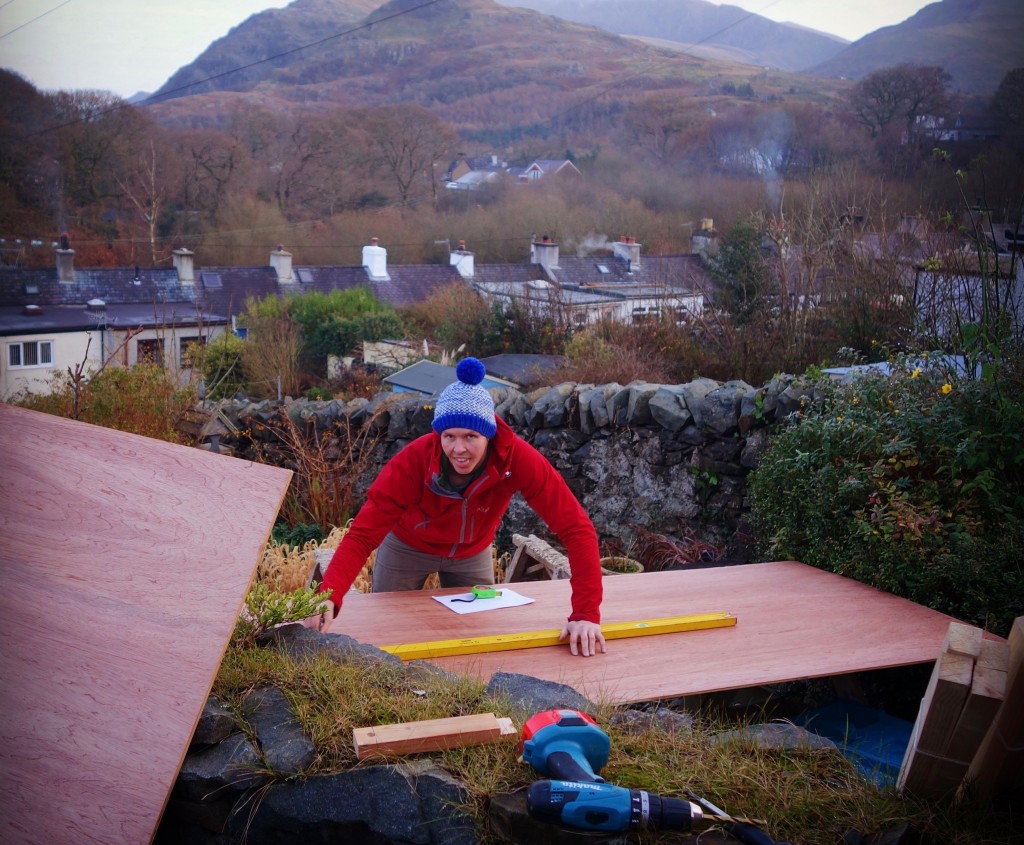
Step 6: The roof
We cut tongue and groove to fit the roof, and screwed it up with self-tappers. It was a bit fiddly, but looks great! Don’t forget to cut holes for the lights if you are putting downlighters in, and wait ’til theres are wired in (step 10) before screwing the roof in place.
Step 7: Leisure battery
We installed a 110 amp leisure battery to power lights, laptops and a row of USB sockets and 12 Volt sockets (i.e. like a car cigarette lighter). You can buy bigger batteries for more power if you want. There are how-to videos on wiring these to your car battery on Youtube, but if in doubt, ask an expert.
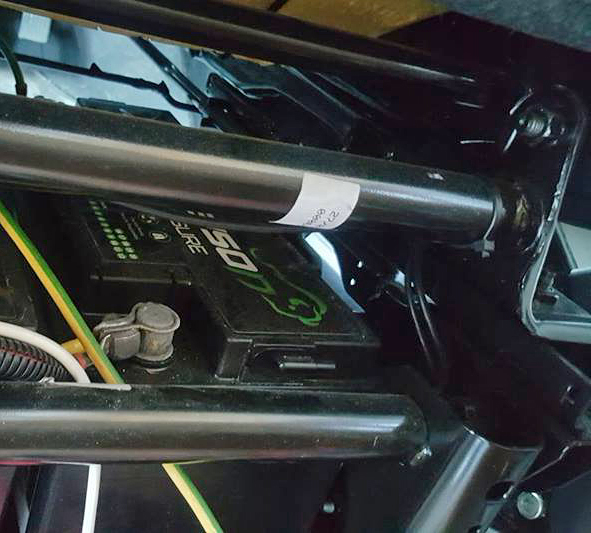
Step 8: 12 volt sockets and USB ports
We decided against adding an inverter, which allows you to install household plug sockets, because decent ones are expensive. You can buy laptop chargers and loads of other appliances with 12v plugs anyway, and then wire sockets for these and USBs straight to the leisure battery.
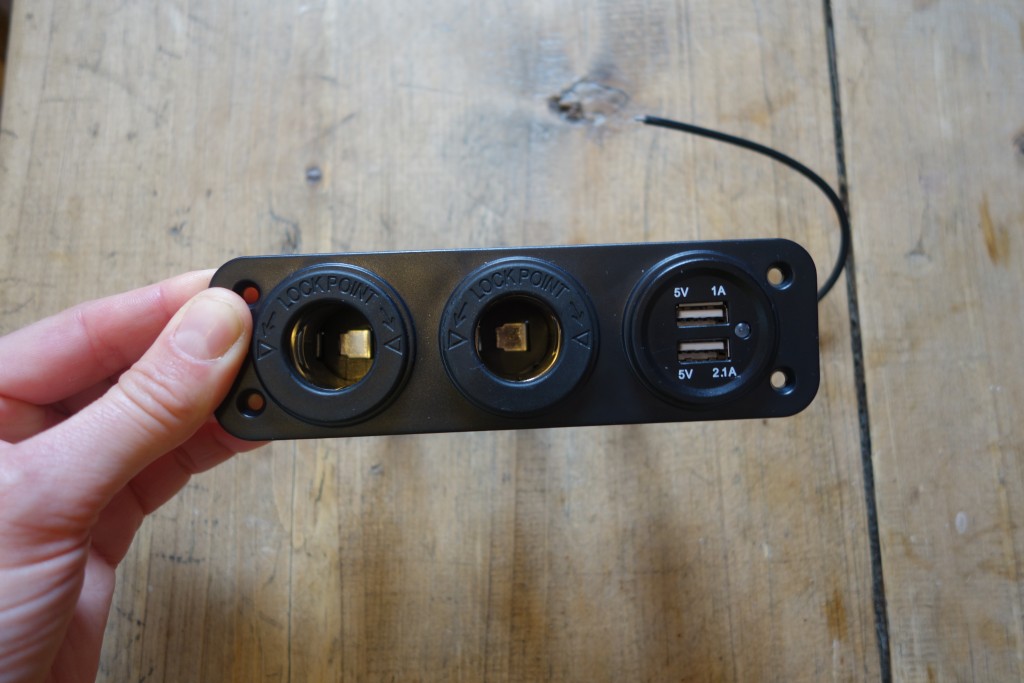
Step 9: Volt sensitive relay
A split charge system is essential for charging two batteries (your car battery and the leisure battery) at the same time, while ensuring that you can’t drain the car battery. A volt sensitive relay is an efficient option. Again, watch Youtube video, or ask an expert.
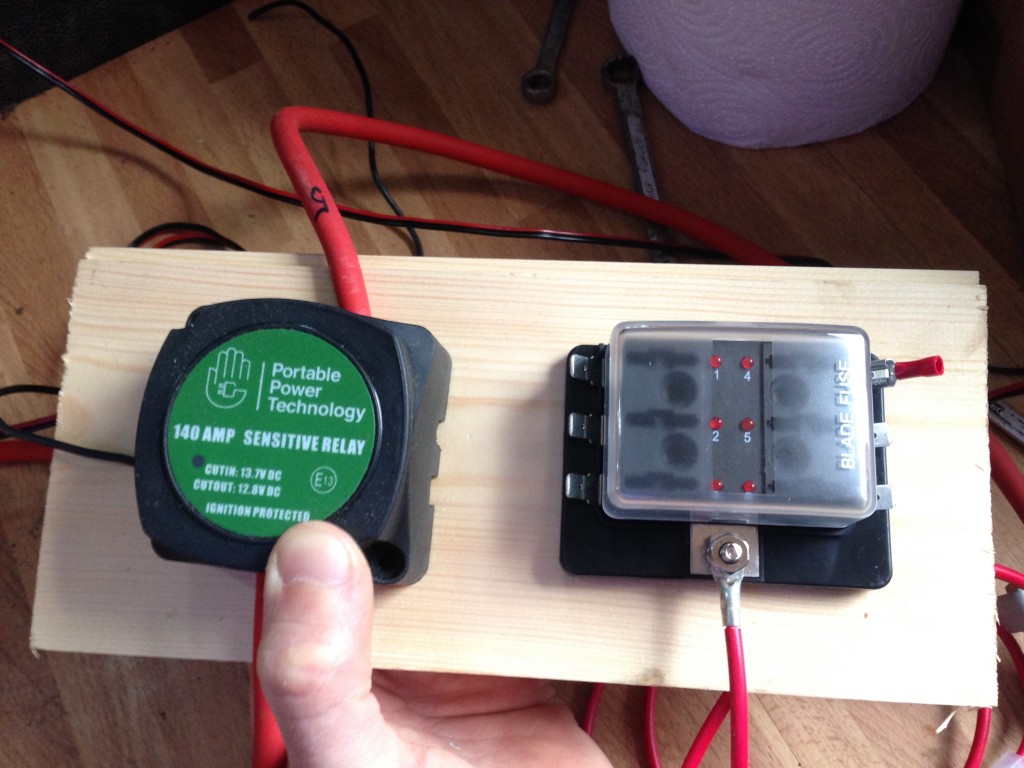
Step 10: LED light set
You can buy simple sets of LED down-lighters specially designed for vans, and wire these to the leisure battery. We added a dimmer switch for mood lighting. Don’t forget to add a fusebox to your wiring system to avoid blowing up your appliances!
Step 11: Furniture building
We built a cupboard for the door side of the van and a long bench opposite it from 2×2” timber and 6mm plywood. Two sheets of plywood rest on top, and we pull one over to meet the cupboard to create a simple double bed. It sits on nubbins screwed to the outside of the bench and the cupboard.
Step 12: Curtains and seat cushions
If you have windows and want to make curtains, I recommend sewing in wadding for warmth and magnets for neatness. You can also buy curtains or simple stick on pads, ready-made. Similarly, you can buy foam for mattress-making online (I’m doing that next!).

Top tips for living that dream #vanlife
Once you’ve bought and converted your van, you have to learn to live in it. I’ve learnt a lot through trial, error, and much experimentation. Here are a few tips I’ve picked up along the way:
1 SHOWER Solar showers are essentially black bags with a shower head that you can heat up in the sun or fill with heated water and hang from your tailgate. Alternatively, behold the rechargeable shower!
2 TOILETS Parking near public toilets or heading for a coffee shop first thing removes the need for a chemical toilet. Carry a trowel and toilet paper for emergencies.
3 HEATING You can install gas (check out Propex) or diesel (Webasto) heaters. Don’t forget to vent through a window and install a carbon monoxide detector. A cheaper, safer option is to wear a down jacket or go to the pub if it’s a chilly evening!
4 COOKING I currently use a small gas-powered camping hob. For something bigger and cheaper, consider Gaslow or Gasit LPG cylinders, which you can refill from petrol stations.
5 FRIDGES If you really need one, consider a 12v cooler fridge, which you can buy for about £50 and keep in an enclosed cupboard. Not as good but much cheaper than a compressor fridge, and they’re removable.
6 SOLAR Panels are reducing in price all the time. Check out portable small Anker panels or Google Bimble Solar for lots of options.
Words and photos by Sarah Stirling
Related Posts
-
 In pictures: Yosemite National Park
by Outdoor Adventure Guide 7 Apr 2016
In pictures: Yosemite National Park
by Outdoor Adventure Guide 7 Apr 2016 -
Follow Jamie Lee on an epic speedflying descent in the Swiss Alps
by Matt Clark 23 Nov 2016
-
 9 of the most spectacular waterfalls in the UK
by Matt Clark 11 Jan 2017
9 of the most spectacular waterfalls in the UK
by Matt Clark 11 Jan 2017 -
Our super-simple guide to fast, light and laidback adventures
by Outdoor Adventure Guide 24 Aug 2015
